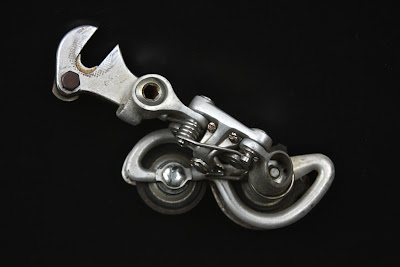Weekending C & V: Huret Rear Derailleur...
I have lately found myself taking some photos of bicycle components, some like this Huret rear derailleur are vintage, while others you are perfectly liable to see on virtually any bike sold out of a shop today. Just as stand-alone objects, I think they are mechanically sculptural. But, of course, they are much more. From a historical perspective they can show the evolution of the activity of bicycling, how changes in design reveal a progression of characteristics such as complexity and simplicity, performance and function, materials. They can reveal which ideas and developments faded into history, and which "caught on", were adopted by the industry and have continued with little change, or have been modified over time.
Up to 1980 Huret was an independent French company producing bicycle components (and most notably derailleurs) such as this rear derailleur. I wish I could provide a sure start date for the company, but am yet to find a decent history of their early years. I do know that they were producing components at least as early as the 1940s. According to Sheldon Brown, Huret's best known model was the Allvit, which was the first inexpensive parallelogram-type derailleur. If you owned a Schwinn Varsity in the 1970s it likely came with an Allvit. Another popular model was the Jubilee, which I believe, is what is shown in the photos here. Again, according to Brown, the Jubilee is the lightest rear derailleur model ever produced, and thus has become highly sought after by collectors. I am not positive of the date of the model shown, though it resembles Huret catalog illustrations from 1973 and 1978, and surely dates to that period. Both catalogs note that the derailleur body is formed of forged light alloy (4.12oz), and that the jockey pulleys use steel ball bearings for smooth function. If you look closely you will notice that only one pulley wheel is toothed, the other smooth. This was typical, and standard at the time.
In 1980 the German company Fichtel & Sachs bought a controlling interest in Huret which gave rise to Sachs-Huret. General belief seems to be that Huret up to this point had been suffering from a decline in design quality, and that the merger provided some relief. Even so, Sachs-Huret was bought by the large German conglomerate, Mannesmann, in 1987. By 1991 the Huret name had been dropped in favor of the simple Sachs.




Nice photo. So this is what Michael does when its raining.
ReplyDelete